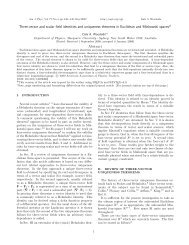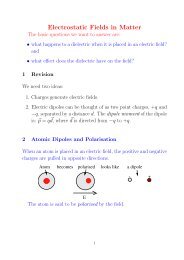Chapter 8 Vector Spaces in Quantum Mechanics
Chapter 8 Vector Spaces in Quantum Mechanics
Chapter 8 Vector Spaces in Quantum Mechanics
Create successful ePaper yourself
Turn your PDF publications into a flip-book with our unique Google optimized e-Paper software.
<strong>Chapter</strong> 8 <strong>Vector</strong> <strong>Spaces</strong> <strong>in</strong> <strong>Quantum</strong> <strong>Mechanics</strong> 83plane, though we will not attempt to prove this here (see Eq. (8.46)). So, any l<strong>in</strong>ear comb<strong>in</strong>ation<strong>in</strong> which a and b are any complex numbers also def<strong>in</strong>es a possible sp<strong>in</strong> state ofthe sp<strong>in</strong> half system. Thus all the possible l<strong>in</strong>ear comb<strong>in</strong>ations of |±〉, i.e. comb<strong>in</strong>ationsof the form a|+〉 + b|−〉 where a and b are complex numbers form a complex vector spaceknown as the state space of the system.The quantum state vectors can also be ‘multiplied’ together – the <strong>in</strong>ner product of the twovectors |S ′ 〉 and |S 〉 is just the probability amplitude 〈S ′ |S 〉. In particular, the basis statesare normalized to unity, i.e. they are unit vectors, and they are orthogonal to each other,i.e. they form a pair of orthonormal basis states.The term<strong>in</strong>ology often adopted is to say that the state vector |S 〉 = a|+〉 + b|−〉 is a ‘l<strong>in</strong>earsuperposition’ of the two states |±〉. The probability amplitudes a = 〈+|S 〉 and b = 〈−|S 〉represent ‘how much’ of the states |±〉 are conta<strong>in</strong>ed with<strong>in</strong> the state |S 〉 to the extent that|〈±|S 〉| 2 is the probability of the z component of sp<strong>in</strong> be<strong>in</strong>g found to have the values ± 1 2 .One difference between ord<strong>in</strong>ary vectors and quantum state vectors is the importance ofthe ‘normalization condition’, i.e. the requirement that 〈S |S 〉 = 1, which must hold truegiven the <strong>in</strong>terpretation of the <strong>in</strong>ner product as a probability amplitude. But how can thisbe reconciled with the statement above that any l<strong>in</strong>ear comb<strong>in</strong>ation of the basis states is apossible state of the system? How can a state vector such as |˜S 〉 = |+〉 + |−〉 which has theproperty〈˜S |˜S 〉 = 2 (8.33)be a physically acceptable state vector as it seems to be say<strong>in</strong>g that the probability off<strong>in</strong>d<strong>in</strong>g the system <strong>in</strong> the state |˜S 〉 given that it is <strong>in</strong> the state |˜S 〉 is 4, which does not makesense. But, if we def<strong>in</strong>e a new vector |S 〉 by|S 〉 =|˜S 〉√〈˜S |˜S 〉= 1 √2|˜S 〉 (8.34)then automatically |S 〉 will have the required normalization property – it is said to benormalized to unity. So, rather than abandon<strong>in</strong>g giv<strong>in</strong>g a physical <strong>in</strong>terpretation of statevectors which are not normalized to unity, the approach adopted is that we can multiplyany state vector by any factor and say that it still represents the same physical state,i.e. |S 〉 and |˜S 〉 = a|S 〉, where a is any complex number, represent the same physical state.However, it is only the normalized state |S 〉 that should be used <strong>in</strong> any calculations <strong>in</strong>order to be certa<strong>in</strong> that probability is properly accounted for.This can be summarized <strong>in</strong> a table:
















